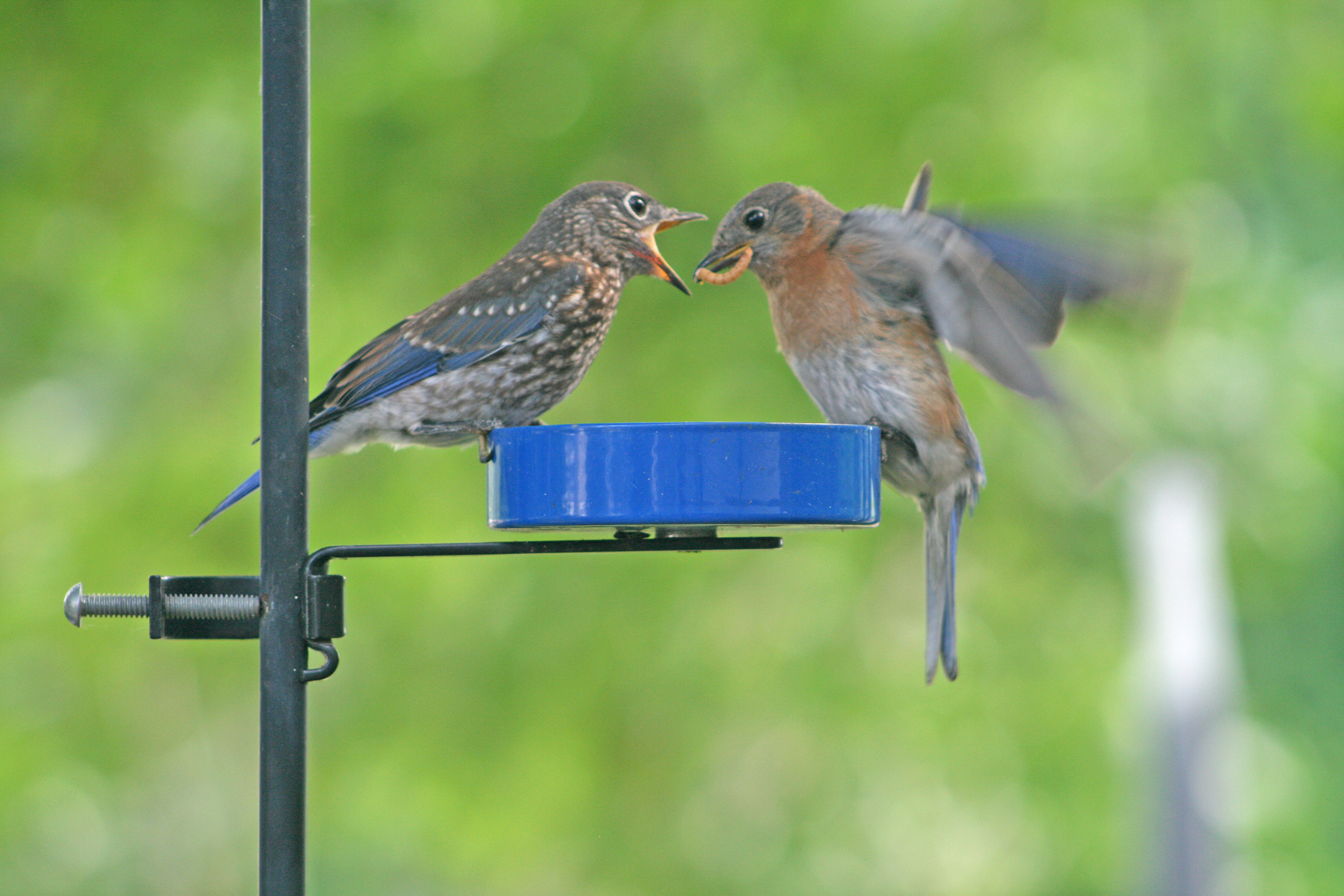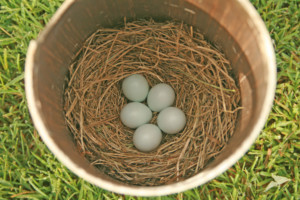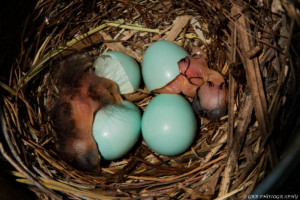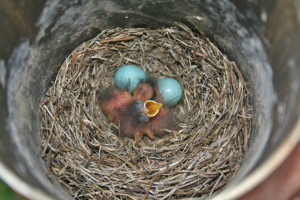Last month, I had an opportunity to interview George Brown, the Ramsey and Washington counties coordinator for the Bluebird Recovery Project. I’ve been aware of the work that Brown has down in coordination with the White Bear Lake All Seasons Wild Bird Store location—setting up their successful bluebird nest boxes and hosting in-store bluebird seminars. I’ve also seen the incredible photos of bluebirds and their nests that George has shared with All Seasons Wild Bird Stores. A birding enthusiast, I’ve always been curious about the bluebird houses I’ve seen in open spaces and parks in my area, so I was grateful for the opportunity to learn more about George’s work with the Bluebird Recovery Project, and of course, for the opportunity to talk birds. Below is my interview with George Brown.
FROM THE BLUEBIRD RECOVERY PROGRAM OF MN TRAIL GUIDE:
The Bluebird is slowly making a comeback. The efforts of all who are providing quality nesting boxes in good habitat locations and monitoring the nest sites is helping to increase the number of bluebirds. If we are to have bluebirds for future generations, they will need our help.
You’re the Ramsey & Washington county coordinator for the Bluebird Recovery Project. What does that entail?
I assist people with setting up a bluebird trail.
What is meant by the term “bluebird trail”?
It’s referring to multiple nesting boxes. Each pair of boxes is one nesting site. Each nesting site is spaced 1000’ apart. If you have 22 boxes, you have 11 nesting sites.
What are your responsibilities for monitoring a bluebird trail?
I set up the nest boxes every March (weather permitting). Then I check the boxes (give it a light squeeze to take it down, look at it, then put it back up) once or twice a week during the summer. I check the boxes for:
- Number of eggs (typically 3-5)
- Check to make sure the eggs are warm (indicating they are being incubated and viable)
- When the eggs hatch (last one hatches between 17-22 days)
- When the birds fledge, I clean out the nest boxes so the birds can fill them up again. You need to clean it out to make sure it’s sanitary.
- If I notice something wrong, I do my best to correct it.
By the way, you can pick up the young from a nest box, gently hold them, and put them back—all is fine. The parents may scold a bit, but they come back.
What are some examples of issues that may need addressing?
- Wrens: they are vicious to bluebirds. They place sticks in multiple nest sites but may not even use the nest. If wrens find eggs or young in a box they want to claim, they’ll destroy the eggs and attack the young—and even the adult bluebirds. Solution: If I find sticks in a nest box, I dump them out.
- House Sparrows: If I find a House Sparrow nest, I dump it out. (Non-native House Sparrows are also predatory to bluebirds).
- Gnats: Buffalo gnats can be an issue for bluebird nests. They haven’t been a big issue on my trail, but you can put a dot of vanilla extract on the nestlings’ heads to discourage the gnats from attacking.
- Ants: These can occasionally be an issue. If ants come in, sometimes birds will lay an egg, then abandon the nest. I know a nest is abandoned if there’s no activity and the eggs are cold. If this is the case, I will throw away the nest and clean the nest of ants and grease the pole. If the eggs are still viable, I’ll briefly remove the eggs from the nest, I’ll scrape out the box, put Vaseline on the pole, then put the eggs back and hope it works out.
- Snakes, racoons: There’s not too much predation on my trails, but I hear of reports of these predators in southern Minnesota sometimes. If you attach a nest box to a tree, it’s a feeding station for raccoons. I’ve seen that. Raccoons can crawl up even ½” conduit, so every few years I sand down the pole to make it slippery so they can’t climb up.
- ???: Sometimes the eggs disappear and it’s a total mystery.
I often see Tree Swallows nesting in bluebird boxes. Are they an issue?
Tree Swallows and bluebirds share territories, so we put nest boxes in pairs. Sometimes they’ll swap boxes for their second brood.
Do the golf courses where you monitor nest boxes see the value of hosting the bluebird trails?
Oh yes! When a new owner came in at one site, the groundskeeper and golfers advocated for keeping the boxes.
You were the 2010 Bluebirder of the Year—can you tell me about that?
That year I had 21 or 22 nest boxes. I think they average out how many eggs were laid, hatched and fledged. My average was 7.2 birds per nesting site (1 site=a pair of 2 boxes, spaced 15’ apart)
The last 2-3 years, I’ve seen a declining population of nesting bluebirds. In our area, fewer bluebirds fledged nests the last few years.
I believe it’s due to the weather. I set up the trails at the end of March and the bluebirds show up predictably on the 1st of April. The last two years there’s been a lot of snow when they arrive, including a blizzard mid-May one year. I can’t set the boxes if I can’t get to them—they’re set on golf courses and there are rules about when you can walk on the damp turf. I had to set out the boxes at the end of April, early May—it was just too late.
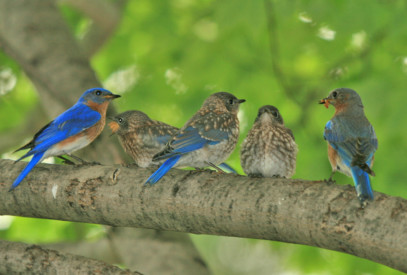
Let’s back up—how did you come to care for bluebirds?
My mother got me started in being interested in birds. She always had bird feeders. I like feathered critters—even parakeets and parrots, which we’ve had as pets. I just like birds!
My wife, Debbie, saw an article in the paper that they were looking for someone to assist with a bluebird trail along Hwy 35, between Stacy and Rock Creek. There were 120 boxes. I took over 40 of those between Stacy and North Branch.
After some close calls with freeway traffic, I decided later that it was too dangerous and decided to stop monitoring the trail. Then I was approached by Loren Murphy and Keith Radel (my mentor) from the Farmington area, who asked if I would continue monitoring bluebirds if the trail were located somewhere safer. I said yes.
That fall, they pulled up the boxes and set up 20 on the Dellwood Hills golf course, and another trail on the Oneka Ridge golf course. I also had another trail on a 40-acre nursery north of Hugo, until just recently when the owner chose to sell the property.
I enjoy it. I get to be out in nature, see the bluebirds close-up, talk with the groundskeepers, and even often ride in a golf cart to check the boxes. The Dellwood golf course is scenic, so I always bring my camera with me. Monitoring bluebirds gives me something to do and also helps to restore the bluebird population. Plus, it’s a good way to teach young people about nature. I sometimes bring my granddaughter with me to see the baby birds.
Tell me about your involvement in setting up bluebird houses at the White Bear Lake All Seasons Wild Bird Store.
My wife Debbie worked there for 16yrs. She talked the manager, Julie, into it. I consulted to help space out the boxes correctly. Then Julie put out a bluebird feeding station of mealworms. They’ve had bluebirds every year since they went in!
I do a presentation on bluebirds in the spring there, setting up a card table and bringing my laptop with pictures. I offer advice on setting up bluebird houses.
What advice would you give for selecting a location to place bluebird houses?
You should have an open area, away from trees to prevent wrens from nesting. You need enough space to place 2 nest boxes, 15’ apart. You can attach a pole to a mailbox. (There’s a ton of great information on the Bluebird Recovery Project website, especially this Bluebird Recovery Program Trail Guide document).
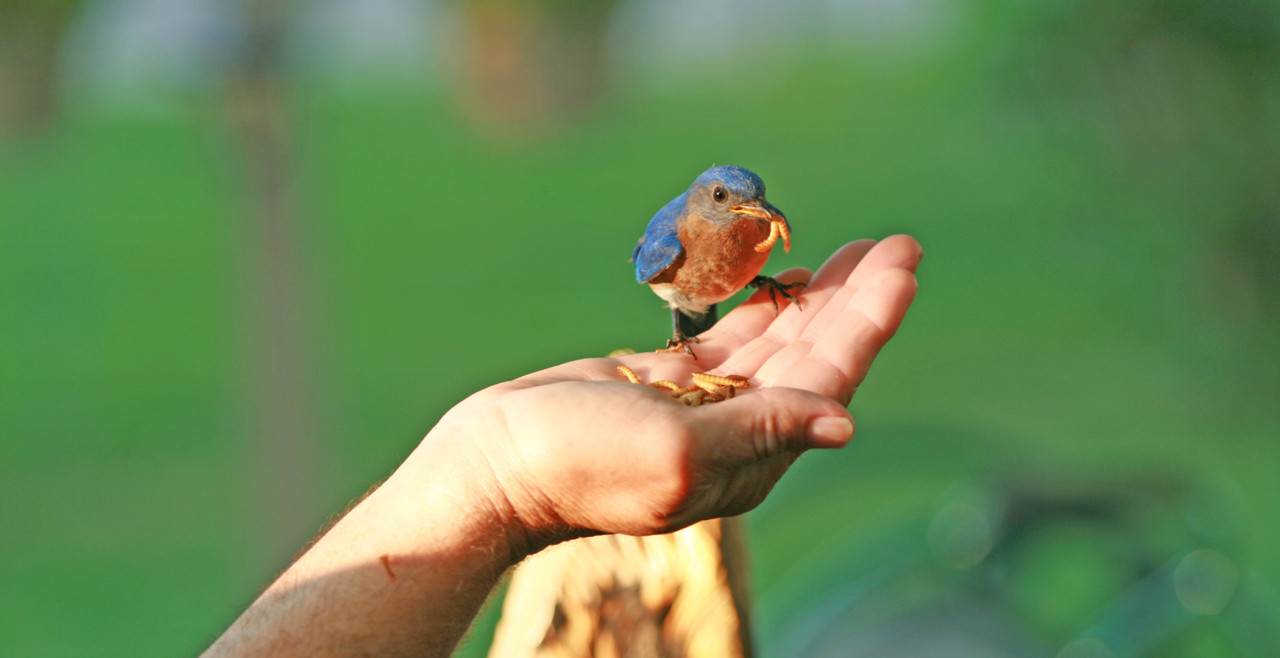
I saw a photograph of you feeding a bluebird mealworms out of the palm of your hand. How did that come about?
I had a blue cup (feeding dish) for feeding mealworms that we got from All Seasons Wild Bird Store. We hung it from a shepherd’s hook pole. When I put out the mealworms, I’d sit on the deck. At first it was half-way to the deck, then I moved it closer a foot or two each day. Then one day I tried putting the cup in my hand and they came! So then I put the worms directly in my hand and they’d eat right from my palm.
They did that all summer, but only the male ever ate from my hand.
I’d put worms out in the morning and evening, whistling to let them know I was there.
I’d sit on the deck and watch for hours. I had a camera on a tripod with a remote so I could snap photos while they ate.
***
Interested in getting started? Our local backyard birding experts can help!
- See our page, Attracting Bluebirds (also available as a take-away sheet in our stores)
- See our Nestbox Basics page for tips on placing houses and information about the eggs you’ll see (also available as a take-away sheet in our stores)
- Shop our selection of bluebird houses. George Brown prefers the composite roof PVC bird house.
By Guest Contributor KATRINA HASE


